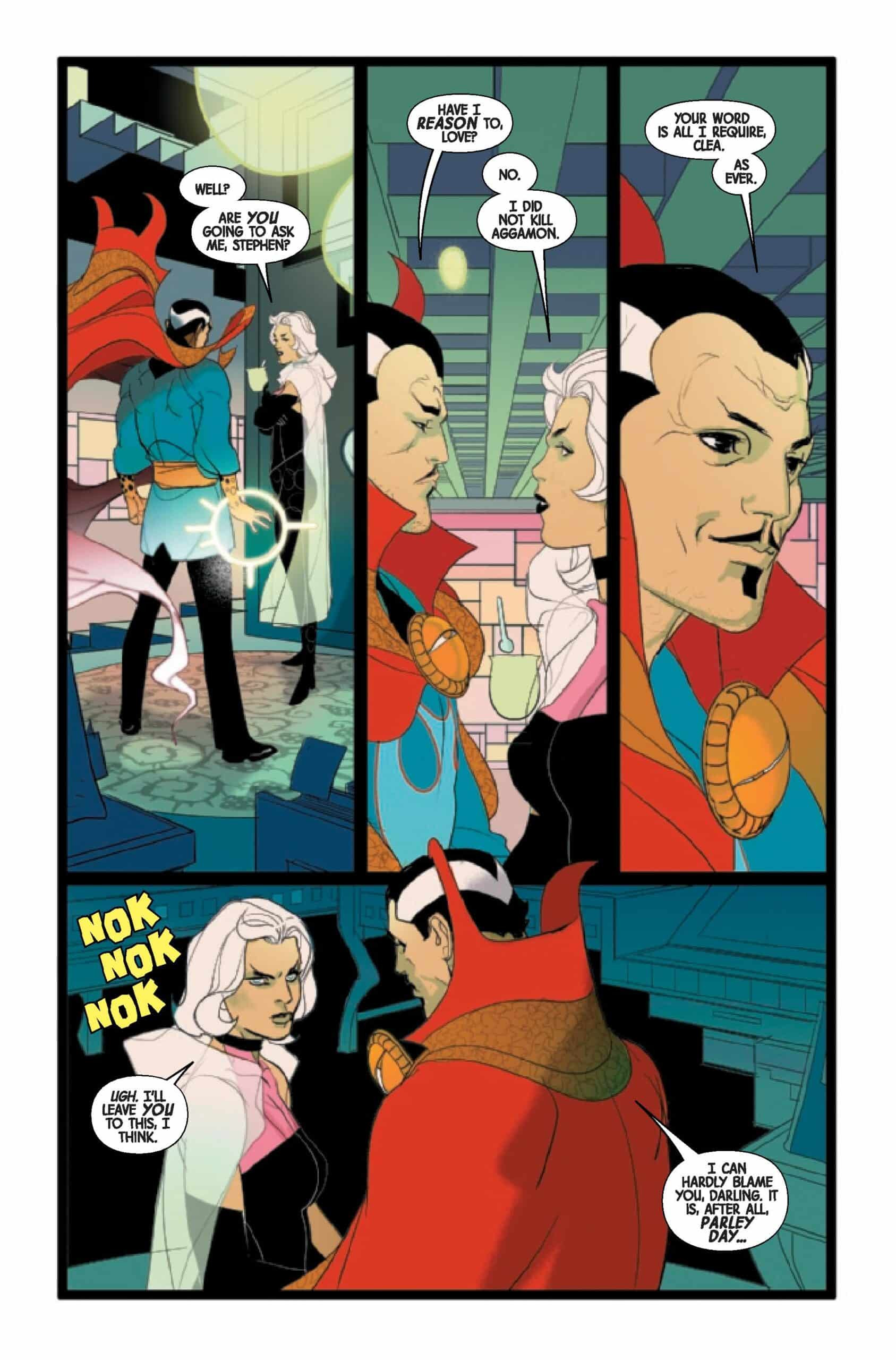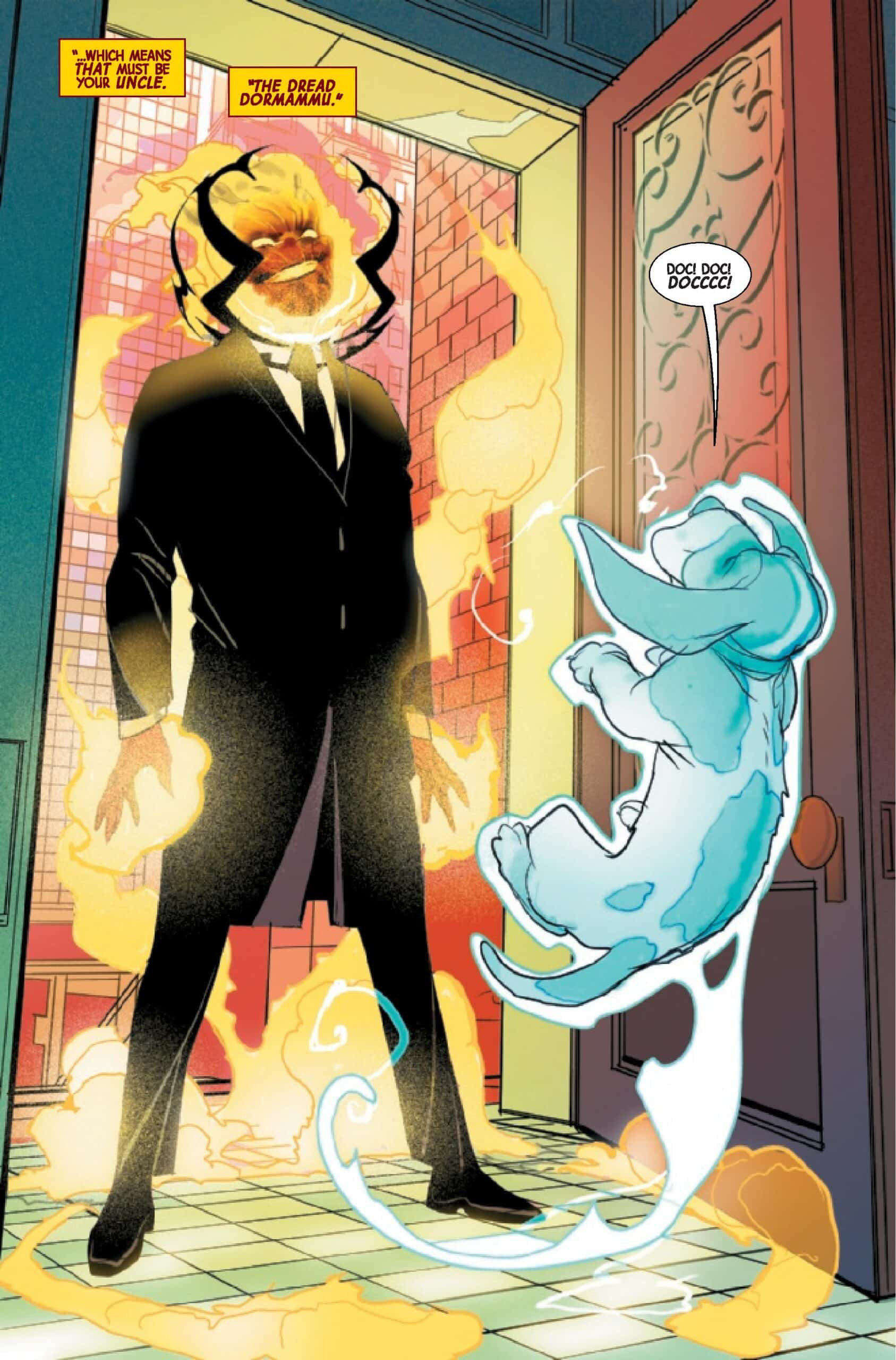The latest installment of the Doctor Strange series continues to captivate, largely due to the compelling dynamics between its characters. Issue #3 deepens the intricate relationship between Stephen Strange and Clea, while also delivering a fascinating face-off with one of Doctor Strange’s most formidable foes: Dormammu. This issue masterfully balances character development with magical conflict, making it a standout chapter in the ongoing saga.
 Doctor Strange and Clea stand side-by-side, Clea looking concerned and Stephen with a determined expression, in a panel from Doctor Strange (2023) Issue 3.
Doctor Strange and Clea stand side-by-side, Clea looking concerned and Stephen with a determined expression, in a panel from Doctor Strange (2023) Issue 3.
The Unbreakable Bond of Stephen and Clea
Writer Jed MacKay expertly navigates the complexities of Stephen and Clea’s relationship. Instead of resorting to manufactured drama, MacKay emphasizes the bedrock of their bond: love and unwavering trust. Despite their differing perspectives and ideologies, Clea and Stephen are presented as an inseparable pair. This strength, however, also hints at potential future conflicts. Their deep trust might lead them to overlook crucial red flags, as seen with Clea’s ambiguous connection to Aggamon’s murder. While Strange readily accepts Clea’s denial, the narrative subtly suggests that there’s more beneath the surface, adding a layer of intrigue to their otherwise solid relationship.
Doctor Strange and Dormammu: A Battle of Wits
The issue truly shines when it brings Doctor Strange into conflict with Dormammu. This confrontation is not a typical superhero brawl, but rather a battle of wits reminiscent of a Constantine story. Strange outmaneuvers Dormammu through clever deception, highlighting his strategic brilliance over brute force. What makes this encounter particularly engaging is the nuanced portrayal of Dormammu. Their exchanges are surprisingly cordial, a departure from their typically antagonistic interactions. This evolved dynamic injects a fresh and entertaining element into their long-standing rivalry. Ultimately, Doctor Strange achieves a moral victory by tricking Dormammu into abandoning his host, showcasing Strange’s growing preference for morally sound solutions, even against cosmic threats. This approach marks a significant development for the Sorcerer Supreme, emphasizing his growth beyond purely magical prowess.
Dormammu’s Elegant and Mystifying Presence
Dormammu’s depiction in this issue is particularly noteworthy. He is presented with an air of regal menace, his constant banter with Strange feeling more like sophisticated sparring than outright animosity. This refined portrayal elevates Dormammu beyond a one-dimensional villain, adding depth and complexity to his character. Visually, Dormammu is a standout. His flaming head and otherworldly form, rendered in Pasqual Ferry’s distinctive art style, effectively convey his immense power and mystical nature, setting him apart from the other characters and reinforcing his status as a major force in the Marvel Universe.
 Dormammu's flaming head dominates the panel as he speaks to Doctor Strange, showcasing Pasqual Ferry's unique art style in Doctor Strange (2023) Issue 3.
Dormammu's flaming head dominates the panel as he speaks to Doctor Strange, showcasing Pasqual Ferry's unique art style in Doctor Strange (2023) Issue 3.
Pasqual Ferry’s Art and Heather Moore’s Colors: A Unique Visual Experience
Pasqual Ferry’s art style is undeniably unique and may divide readers. His approach, characterized by a sketch-like quality and lack of heavy inks, lends the comic an artistic, almost indie feel. While some might find it unconventional for a mainstream comic, it cultivates a distinctive visual identity for the Doctor Strange series. Heather Moore’s coloring faces the challenge of complementing Ferry’s linework. While she skillfully navigates these constraints, there are instances where the pages appear somewhat muted due to the absence of strong inks. However, the artwork truly excels in depicting the fantastical backgrounds and magical elements inherent to a Doctor Strange comic. These aspects of the art team’s collaboration shine, immersing the reader in the mystical realms that Doctor Strange inhabits. While character renderings might occasionally feel less defined, Dormammu remains a striking exception, his design benefiting immensely from Ferry’s style, enhancing his otherworldly aura.
Cory Petit’s lettering deserves praise for its versatility and creativity. Handling both the main story and the backup feature, Petit adapts his style effectively to each narrative. His work on Dormammu’s dialogue is particularly inventive, employing an orange hue and stylistic flourishes that amplify the character’s voice and presence. Overall, the lettering is a significant asset to the comic, seamlessly integrating with the art and enhancing the storytelling.
Alex Ross’s Cover: A Nod to Doctor Strange’s Legacy
Alex Ross’s cover art for this issue is another highlight, prominently featuring Dormammu. The cover is a clear homage to classic Doctor Strange iterations, reminiscent of Steve Ditko’s iconic work. Ross’s painted style, a hallmark of his popular pieces, combined with a background echoing his Fantastic Four work, creates a visually striking and nostalgic image. The vibrant colors and dynamic design elements make this cover a standout, capturing the essence of Doctor Strange and the imposing presence of Dormammu.
Backup Story: Nico Minoru and Dormammu’s Lingering Influence
The backup story, crafted by Amy Chu, Tokitoroko, and Fer Sifuentes-Suto, shifts focus to Nico Minoru as she grapples with personal loss. Dormammu’s presence extends beyond the main narrative, as he appears demanding Nico’s Staff of One. While the plot is straightforward, it effectively showcases Nico’s powers and her conflicted relationship with her magical abilities. However, the story revisits Nico’s uncertainty about her staff’s functionality, a theme previously explored in Runaways comics, making it feel somewhat repetitive.
Tokitoroko’s art style in the backup story offers a stark contrast to Ferry’s, embracing manga and anime influences. Fer Sifuentes-Suto’s colors amplify this aesthetic, resulting in a visually energetic and distinct segment. Petit’s lettering also adapts to this style, contributing to the backup story’s unique identity. The art style effectively conveys the action-oriented nature of Nico’s confrontation, though the narrative itself remains quite basic.
Conclusion: A Strong Issue for Doctor Strange Fans
Doctor Strange #3 is a commendable addition to the series, particularly for its compelling exploration of character dynamics and the intriguing conflict between Doctor Strange and Dormammu. The issue excels in presenting a nuanced Dormammu, moving beyond typical villain tropes to offer a more sophisticated and even cordial antagonist. Pasqual Ferry’s distinctive art style, while potentially divisive, contributes to the book’s unique identity and effectively captures the mystical elements of the Doctor Strange universe, especially in the portrayal of Dormammu. While the backup story is less impactful, the main narrative and art make this issue a worthwhile read for Doctor Strange enthusiasts and those interested in seeing a different kind of magical confrontation.

